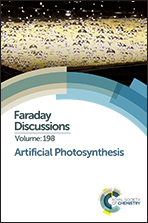Hydricity, electrochemistry, and excited-state chemistry of Ir complexes for CO2 reduction†
Abstract
We prepared electron-rich derivatives of [Ir(tpy)(ppy)Cl]+ with modification of the bidentate (ppy) or tridentate (tpy) ligands in an attempt to increase the reactivity for CO2 reduction and the ability to transfer hydrides (hydricity). Density functional theory (DFT) calculations reveal that complexes with dimethyl-substituted ppy have similar hydricities to the non-substituted parent complex, and photocatalytic CO2 reduction studies show selective CO formation. Substitution of tpy by bis(benzimidazole)-phenyl or -pyridine (L3 and L4, respectively) induces changes in the physical properties that are much more pronounced than from the addition of methyl groups to ppy. Theoretical data predict [Ir(L3)(ppy)(H)] as the strongest hydride donor among complexes studied in this work, but [Ir(L3)(ppy)(NCCH3)]+ cannot be reduced photochemically because the excited state reduction potential is only 0.52 V due to the negative ground state potential of −1.91 V. The excited state of [Ir(L4)(ppy)(NCCH3)]2+ is the strongest oxidant among complexes studied in this work and the singly-reduced species is formed readily upon photolysis in the presence of tertiary amines. Both [Ir(L3)(ppy)(NCCH3)]+ and [Ir(L4)(ppy)(NCCH3)]2+ exhibit electrocatalytic current for CO2 reduction. While a significantly greater overpotential is needed for the L3 complex, a small amount of formate (5–10%) generation in addition to CO was observed as predicted by the DFT calculations.
- This article is part of the themed collection: Artificial Photosynthesis


 Please wait while we load your content...
Please wait while we load your content...